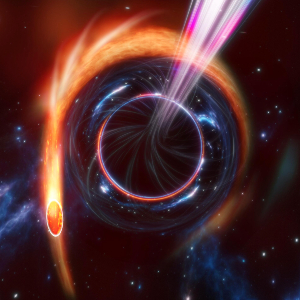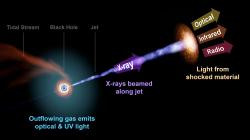The furious tearing of the star by the supermassive hole emitted an extremely bright flash
The extremely bright flash of AT 2022cmc, detected this February by the practical Zwicky Transient Facility, is according to astronomers a record TDE event, or the consumption of an unwary star by a supermassive black hole. It was the brightest and also the most distant we have observed so far. The tortured star’s blast of energy and matter was aimed directly at Earth, albeit from a perfectly safe distance of 8.5 billion light-years.
Dechberoucí událost TDE. Credits: Carl Knox – OzGrav, ARC Center of Excellence for Gravitational Wave Discovery, Swinburne University of Technology.
The remarkable Zwicky Transient Facility operating at the Palomar Observatory is an excellent tool for detecting sudden events in the sky. These are different phenomena and some are truly exceptional. This was exactly the event detected by the Zwicky device on February 11th of this year (2022). It was a tremendously bright flash, the intensity of which astronomers estimated at the time at about 1000 billion suns. The world took notice, and other telescopes focused on the unusual flash, which scoured the sky not only in the visible but also, for example, in the X-ray, ultraviolet or radio range.
A large team of astronomers led by Dheeraj R. Pasham, known as “DJ”, of the Kavli Institute for Astrophysics and Space Research of the American MIT, was recently able to determine the probable source of the aforementioned signal, which has been designated AT 2022cmc , from many data. The researchers concluded that it was a very intense relativistic jet coming from the immediate vicinity of a supermassive black hole.
The black hole in question, which is about 8.5 billion light-years away, appears to have torn apart the unwary star furiously and in a short space of time, releasing a gigantic amount of energy.
If they are right, then this is a tidal disruption event (TDE). It is a record in many respects. AT 2022cmc is the brightest TDE event we have ever observed. It is also the most distant known TDE event that occurred when the universe was less than half the age of the universe. Finally, this is the first TDE event discovered in an optical survey of the sky.
How is it possible that an event so distant appears so clear to us? According to Pasham and his colleagues, the Doppler enhancement has manifested itself. In other words, this relativistic jet was aimed directly at the Earth. It was therefore clearer than if it was going in any other direction.
The study of TDE events is very important for understanding the evolution of supermassive black holes and the galaxies that surround them. In today’s universe, we see a sea of galaxies, with virtually every decent galaxy having a supermassive black hole at its center. We know that supermassive black holes have appeared in the universe surprisingly quickly. But we still don’t know much about how it happened. How ancient supermassive black holes grew and exploded. TDE events, or the consumption of stars by supermassive black holes, can tell us something interesting about this.
Video: A black hole more than half the size of the Universe that emits matter at nearly the speed of light
Video: How to find zombie stars, aka black holes! | Dheeraj Pasham | TEDxDornbirn
Literature
Naturalistic astronomy online 30. 11. 2022.




